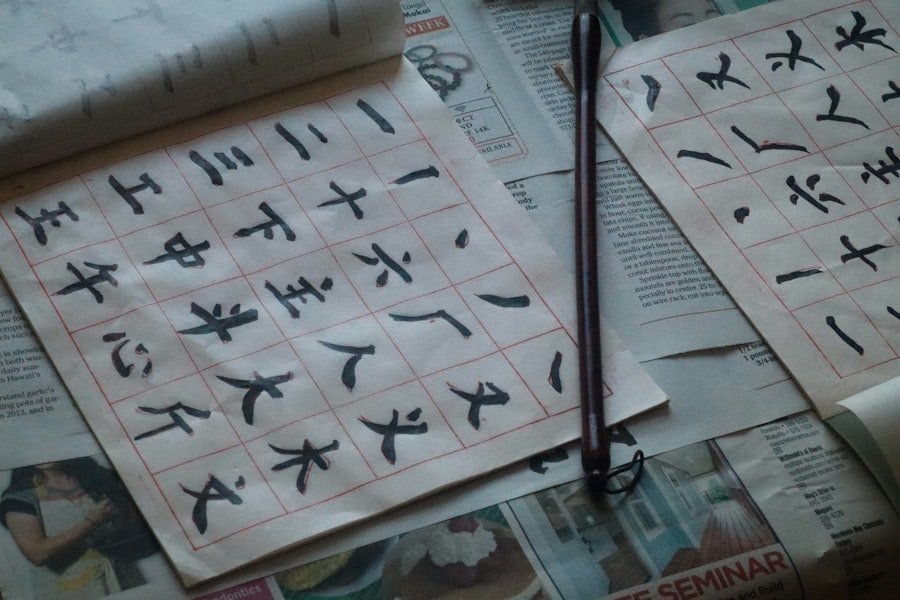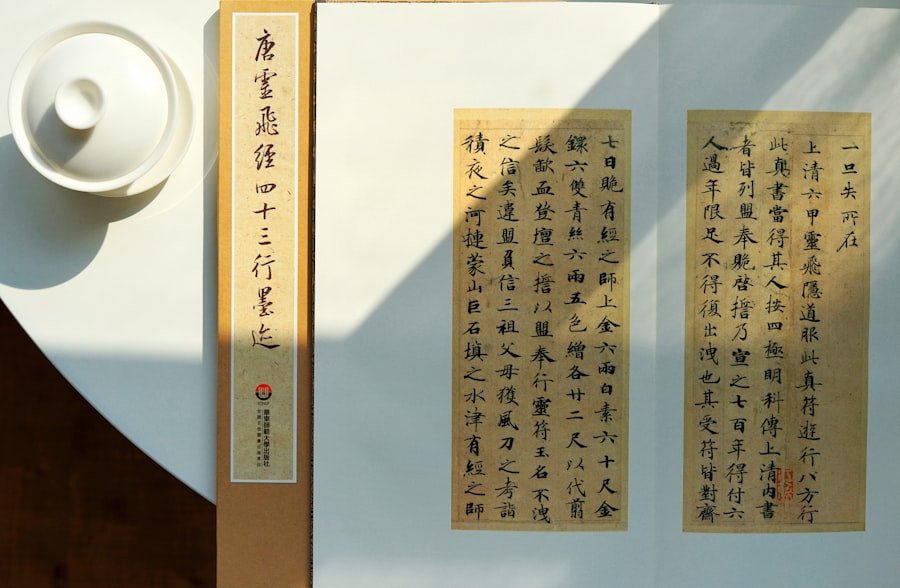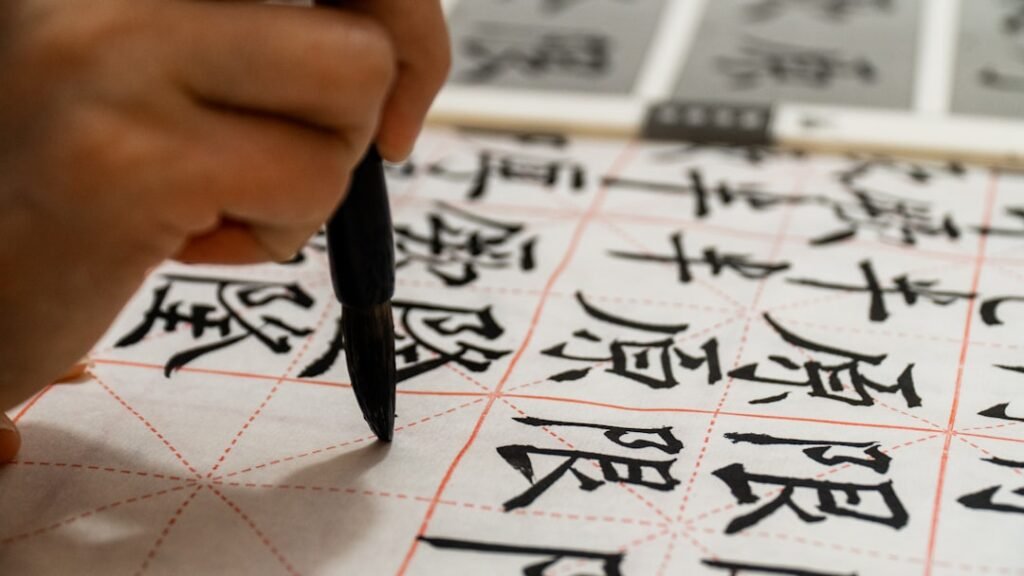Yong (永字八法), often referred to as the “Eight Principles of the Character Yong,” serves as a cornerstone in the study of Chinese calligraphy. This character, which translates to “eternity,” is not merely a word but a complex representation of the art form itself. The eight fundamental strokes that compose this character are essential for any aspiring calligrapher, as they encapsulate the essence of brushwork and technique.
Mastering these strokes is akin to learning the alphabet in Western languages; they form the building blocks of more intricate characters and styles. The significance of Yong (永) extends beyond its literal meaning. It embodies the philosophy and aesthetics of Chinese calligraphy, where each stroke is imbued with emotion and intention.
As students delve into the intricacies of these strokes, they not only learn to write but also to appreciate the cultural heritage that has shaped this ancient art form. The journey through Yong (永字八法) is one of discovery, discipline, and deep connection to a tradition that has flourished for centuries. Master the art of Chinese calligraphy. Enroll now at the LC Chinese School in Oslo.
Table of Contents
ToggleSummary
- Yong (永字八法) is a set of 8 fundamental strokes in Chinese calligraphy, essential for mastering the art form.
- The history of Yong (永字八法) dates back to ancient China and holds great significance in Chinese calligraphy tradition.
- Each of the 8 fundamental strokes in Yong (永字八法) carries its own unique meaning and symbolism, representing different elements of nature and life.
- Mastering Yong (永字八法) is crucial for aspiring calligraphers, as it forms the foundation for creating beautiful and balanced Chinese characters.
- Practicing and perfecting the 8 fundamental strokes of Yong (永字八法) requires dedication and patience, but it is essential for achieving mastery in Chinese calligraphy.
History and significance of Yong (永字八法) in Chinese calligraphy
The origins of Yong (永字八法) can be traced back to the Tang Dynasty, a period renowned for its cultural and artistic achievements. During this time, calligraphy was elevated to an art form, with scholars and artists dedicating their lives to perfecting their brushwork. The character Yong was chosen as a model due to its complexity and the variety of strokes it encompasses.
This selection was not arbitrary; it reflects the belief that mastering this character would provide a solid foundation for understanding the nuances of calligraphy. The significance of Yong (永字八法) lies in its role as a pedagogical tool. For centuries, it has been used in calligraphy schools across China as a primary teaching method.
The eight strokes serve as a guide for students, helping them to develop their skills systematically. Each stroke is not only a technical exercise but also a means of connecting with the philosophical underpinnings of Chinese art. As students practice these strokes, they engage with concepts such as balance, rhythm, and flow—elements that are crucial in creating harmonious compositions.
The meaning and symbolism behind the 8 fundamental strokes

The eight fundamental strokes of Yong (永字八法) are more than mere lines on paper; they are imbued with rich symbolism and meaning. Each stroke represents a different aspect of life and nature, reflecting the interconnectedness of all things in Chinese philosophy. For instance, the horizontal stroke signifies stability and balance, while the vertical stroke embodies strength and resilience.
Together, these strokes create a visual language that speaks to the harmony inherent in the universe. Moreover, each stroke carries its own unique characteristics that contribute to the overall expression of the character. The “dot” stroke, for example, is often seen as a representation of beginnings or seeds, while the “hook” stroke suggests movement and dynamism.
Understanding these symbolic meanings allows calligraphers to infuse their work with deeper significance, transforming each piece into a reflection of their personal journey and artistic vision.
The importance of mastering Yong (永字八法) in Chinese calligraphy
Mastering Yong (永字八法) is crucial for anyone serious about pursuing Chinese calligraphy. These eight strokes form the foundation upon which all other characters are built, making them indispensable for developing technical proficiency. Without a solid grasp of these fundamental strokes, a calligrapher may struggle to achieve the fluidity and grace that characterise high-quality work.
Thus, dedicating time to practice Yong (永) is essential for anyone wishing to excel in this art form. Furthermore, mastering these strokes fosters a deeper understanding of the principles that govern calligraphy as a whole. As students become adept at executing each stroke with precision and confidence, they begin to appreciate the subtleties of brush control, pressure, and speed.
This mastery not only enhances their technical skills but also cultivates an intuitive sense of rhythm and flow—qualities that are vital for creating captivating compositions. In essence, Yong (永字八法) serves as both a practical guide and a philosophical framework for aspiring calligraphers.
Exploring the individual strokes of Yong (永字八法)
Each of the eight strokes in Yong (永字八法) has its own distinct characteristics and techniques associated with it. The first stroke, known as “the horizontal stroke,” is foundational in establishing balance within characters. It requires a steady hand and an understanding of pressure application to create an even line that conveys stability.
The second stroke, “the vertical stroke,” contrasts with its horizontal counterpart by introducing a sense of upward movement. This stroke demands precision and control, as it often serves as a backbone for many characters. The third stroke, “the left-falling stroke,” adds dynamism to the composition, while “the right-falling stroke” introduces an element of gracefulness.
Each stroke builds upon the last, creating a rich tapestry of movement and expression. As students explore these individual strokes, they begin to understand how each contributes to the overall character’s form and meaning. This exploration is not merely technical; it is an artistic journey that encourages self-expression and creativity.
By experimenting with variations in pressure, speed, and angle, calligraphers can develop their unique style while remaining rooted in tradition.
Techniques for practicing and perfecting the 8 fundamental strokes

Practicing Yong (永字八法) requires dedication and an understanding of various techniques that can enhance one’s skills. One effective method is to break down each stroke into smaller components, allowing students to focus on mastering one aspect at a time. For instance, when practising the horizontal stroke, one might begin by drawing short lines before gradually increasing their length and complexity.
Another valuable technique involves using different types of brushes and papers to explore how these materials affect stroke execution. A soft brush may yield different results compared to a stiff one, while various paper textures can influence ink absorption and flow. Experimenting with these variables can lead to greater insight into one’s personal style and preferences.
Additionally, maintaining a consistent practice schedule is essential for improvement. Regularly dedicating time to practice not only reinforces muscle memory but also fosters a deeper connection with the art form. Many calligraphers find it beneficial to set specific goals for each practice session, whether it be perfecting a particular stroke or experimenting with new compositions.
Common mistakes to avoid when learning Yong (永字八法)
As with any skill, there are common pitfalls that learners may encounter when studying Yong (永字八法). One frequent mistake is neglecting proper posture and grip while holding the brush. An improper grip can lead to tension in the hand and wrist, resulting in uneven strokes and fatigue.
It is crucial for students to adopt a relaxed yet controlled grip that allows for fluid movement. Another common error is rushing through practice sessions without focusing on quality over quantity. While it may be tempting to produce numerous characters quickly, this approach often leads to sloppy work and reinforces bad habits.
Instead, learners should prioritise slow, deliberate practice that emphasises precision and control. Additionally, many beginners overlook the importance of observing experienced calligraphers’ work. Studying the techniques employed by masters can provide invaluable insights into brushwork and composition.
By analysing their strokes and styles, students can gain inspiration and refine their own practice.
The role of Yong (永字八法) in different styles of Chinese calligraphy
Yong (永字八法) plays a significant role across various styles of Chinese calligraphy, from traditional forms like Kaishu (regular script) to more expressive styles such as Xingshu (running script) and Caoshu (grass script). Each style interprets the eight fundamental strokes differently, allowing for unique expressions while remaining rooted in tradition. In Kaishu, for instance, precision and clarity are paramount; thus, the strokes are executed with meticulous attention to detail.
Conversely, Xingshu embraces fluidity and spontaneity, allowing calligraphers to infuse their personality into each piece while still adhering to the principles established by Yong (永). Caoshu takes this further by prioritising speed and expressiveness over strict adherence to form. Understanding how Yong (永字八法) adapts across these styles enables students to appreciate the versatility of Chinese calligraphy as an art form.
It encourages them to experiment with different techniques while remaining grounded in the foundational principles that unite all styles.
How to incorporate Yong (永字八法) into your own calligraphy practice
Incorporating Yong (永字八法) into one’s own calligraphy practice can be both rewarding and transformative. One effective approach is to set aside dedicated time for focused practice on each of the eight strokes individually before attempting to combine them into complete characters or phrases. This method allows students to build confidence in their abilities while reinforcing their understanding of each stroke’s unique characteristics.
Additionally, learners can experiment with integrating Yong (永) into their personal projects by creating original compositions that highlight these fundamental strokes. This could involve crafting poems or quotes that resonate with them while consciously applying the principles learned from Yong (永字八法). Such projects not only enhance technical skills but also foster creativity and self-expression.
Moreover, joining a community or class focused on Chinese calligraphy can provide valuable feedback and support as students navigate their artistic journeys. Engaging with fellow enthusiasts allows for shared learning experiences and inspiration from diverse perspectives.
Famous examples of Yong (永字八法) in Chinese calligraphy
Throughout history, many renowned calligraphers have left their mark by showcasing Yong (永字八法) in their works. One notable example is Wang Xizhi, often regarded as one of China’s greatest calligraphers from the Eastern Jin Dynasty. His interpretation of Yong exemplifies fluidity and grace while maintaining adherence to traditional principles.
Another prominent figure is Yan Zhenqing from the Tang Dynasty, whose bold strokes convey strength and character. His rendition of Yong reflects his mastery over brushwork while infusing his unique style into each stroke. These examples serve as inspiration for contemporary calligraphers seeking to understand how Yong (永字八法) has been interpreted throughout history.
By studying these masterpieces, learners can gain insights into various techniques and approaches that have shaped Chinese calligraphy over time.
The enduring legacy of Yong (永字八法) in Chinese calligraphy
The legacy of Yong (永字八法) endures as an essential component of Chinese calligraphy education and practice. Its eight fundamental strokes serve not only as technical exercises but also as gateways into understanding the rich cultural heritage that surrounds this art form. As students engage with these strokes, they embark on a journey that transcends mere writing; they connect with centuries of tradition while developing their unique artistic voice.
At LC Chinese School in Oslo, we offer specialised courses in Chinese calligraphy that emphasise the importance of mastering Yong (永字八法). Our experienced instructors guide students through each stroke’s intricacies while fostering an appreciation for this timeless art form’s beauty and significance. Whether you are a beginner or an experienced practitioner looking to refine your skills, our courses provide an enriching environment where you can explore your creativity while honouring tradition.
In conclusion, embracing Yong (永字八法) opens doors to endless possibilities within Chinese calligraphy—a journey marked by discipline, creativity, and profound connection to an ancient art form that continues to inspire generations worldwide.
Master the art of Chinese calligraphy. Enroll now at the LC Chinese School in Oslo.







